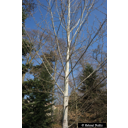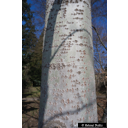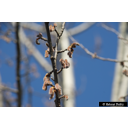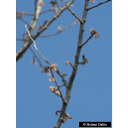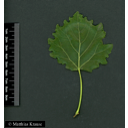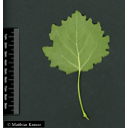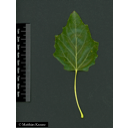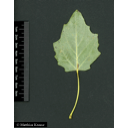Useful information about the taxon (species, subspecies, variety...)
Populus × canescens (Aiton) Sm. 1804
P. alba × P. tremula
Salicaceae
(APG IV)grey poplar
Akzessionnummer: SP-LB-014-10156
Pflanzjahr: 2004
Taxon concept: The Plant List (2014), version 1.1
Distribution: Europe without Scandinavia and Iberian Peninsula; Turkey, Caucasus; introduced to Scandinavia, Iberian Peninsula and to the United States
Size: 15 - 20 (m)Flowering period: II - IV
Populus canescens (Aiton) Sm. - Accepted: Populus canescens (Aiton) Sm. bei The Plant List (2010); Familie: Salicaceae (APG III)Populus × canescens (Aiton) Sm. - Accepted: Populus × canescens (Aiton) Sm. bei Zander 2008; Familie: Salicaceae (Zander 2008)Populus × canescens (Aiton) Sm. - Synonym: Populus canescens (Aiton) Sm. bei The Plant List (2010); Familie: Salicaceae (APG III)Populus canescens (Aiton) Sm. - Synonym: Populus × canescens (Aiton) Sm. bei The Plant List (2014), version 1.1; Familie: Salicaceae (APG III)Populus × canescens (Aiton) Sm. - Accepted: Populus × canescens (Aiton) Sm. bei The Plant List (2014), version 1.1; Familie: Salicaceae (APG III)Populus canescens (Aiton) Sm. - Accepted: Populus canescens (Aiton) Sm. bei BfN Checklist Flora DE; Familie: Salicaceae (APG IV)Populus × canescens (Aiton) Sm. - Accepted: Populus × canescens (Aiton) Sm. bei World Flora Online - APG IV (Angiosperms); Familie: Salicaceae (World Flora Online - APG IV (Angiosperms))
- Flower ecology
- wind-pollinated (anemophilous)
- Life form
- woody, tree
- Foliage persistence
- deciduous
- Soil conditions
- on a wide range of soil conditions; preferentially on moist, well-drained soils; pioneer plant on immature soils
- Light conditions
- full sun to partial sun plant
- Succession type
- pioneer species, soil stabiliser
- Natural occurrence (habitat)
- immature soils and wetlands, bottomland deciduous forests
- Comment to ecology
- probably a hybrid of P. alba x P. tremula
- Vegetation typ and synecology (plant community)
- temperate broad-leaved deciduous forests
- Natural propagation (all types)
- by means of adventitious roots, stem sprouts
- Constraints according radiation (light)
- not shade tolerant
- Recommendation (regional context)
- not suitable as street tree
- Status of alien naturalisation
- indigenous
- Related to region
- wildly occurring at Rhine, Danube
Breunig, T. et al. (2021): Rote Liste der Farn- und Blütenpflanzen Baden-Württembergs.; Bundesamt für Naturschutz (BfN) (1999-2001 and ongoing): Floraweb - Daten und Informationen zu Wildpflanzen und zur Vegetation Deutschlands. www.floraweb.de.; Erhardt, W., Götz, E., Bödeker, N. & Seybold, S. (2008): Der große Zander. Enzyklopädie der Pflanzennamen. Band 2. Arten und Sorten. Eugen Ulmer KG, Stuttgart (Hohenheim), 18. Aufl., 2103 S.; Haider, M. et al. (2005): Wildbienenkataster. See: https://www.wildbienen-kataster.de; Jäger, E. (Hrsg.) (2011): Rothmaler - Exkursionsflora von Deutschland. Gefäßpflanzen: Grundband. Band 2. Springer Spektrum Verlag, 20., neu bearb. u. wesentl. erw. Aufl.: 944 S. 978-3-8274-1606-3.; Metzing, D. et al. (2018): Rote Liste und Gesamtartenliste der Farn- und Blütenpflanzen (Trachaeophyta) Deutschlands .; Ministerium für Ernährung, Landwirtschaft, Umwelt und Forsten, Baden-Württemberg (Hrsg.) (1985): Pflanzenkatalog zur Verbesserung der Bienenweide und des Artenreichtums (Kurztitel: Bienenweidekatalog); Oberdorfer, E. (2001): Pflanzensoziologische Exkursionsflora. Für Deutschland und angrenzende Gebiete. Eugen Ulmer Verlag, Stuttgart, 8., stark überarb. u. erg. Aufl, 1056 S. 978-3-8001-3131-0.; Plants for a Future (1996-2012): PFAF. See: https://pfaf.org/; The International Plant Names Index (2009). Published on the Internet http://www.ipni.org; Courtesy to IPNI, 2009. Exported from IPNI at date: 2009-09-22 20:17:51; The IUCN Red List of Threatened Species. www.iucnredlist.org; Westrich, P. et al. (2018): Die Wildbienen Deutschlands.. Ulmer Verlag ISBN 978-8186-0123-2.;
Diese Webseite verwendet Google Maps, um Karten und Standorte von Pflanzen in den Hohenheimer Gärten anzuzeigen. Dadurch werden unter Umständen Daten an Google weitergeleitet, was mit einer Verarbeitung Ihrer personenbezogenen Daten verbunden sein kann. Die Datenschutzerklärung von Google finden Sie hier: Datenschutzerklärung von Google

